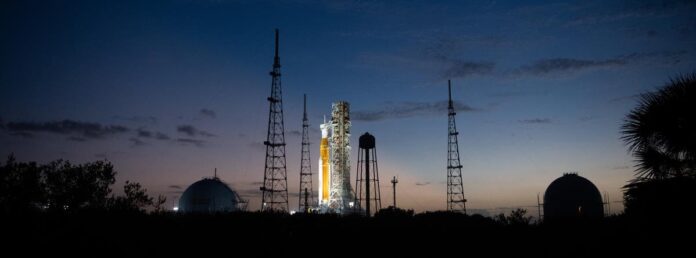Nasa decided Tuesday evening to delay the launch date of its Artemis I mission as the space agency prepares its big Moon rocket to weather near hurricane-strength winds at the launch pad in the face of the approaching Tropical Storm Nicole.Nasa had been targeting Monday 14 as the date to finally launch its long-awaited Moon mission, but will now shift for an expected launch no earlier than 1.04pm EST on Wednesday 16 November, with a backup date of 19 November.’Adjusting the target launch date will allow the workforce to tend to the needs of their families and homes, and provide sufficient logistical time to get back into launch status following the storm,’ Nasa announced in a blog post on Tuesday evening.US National Oceanic and Atmospheric Administration (Noaa) forecasters now expect Tropical Storm Nicole to strengthen into a category 1 hurricane by the time it makes landfall along the southeastern Florida coast sometime Wednesday.Category 1 hurricanes can sustain winds up to 95 miles-per-hour, according to Noaa.Located south of Daytona beach and north of Port Saint Lucie along Florida’s east coast, Kennedy Space Center, and specifically Cape Canaveral Space Force Station, where Nasa’s Moon rocket waits on the launch pad, could be in the line of fire of Nicole. But Nasa officials believe the Space Launch System (SLS), the massive rocket that will launch the Artemis I mission into orbit, can handle the oncoming storm, according to the space agency announcement.’The greatest risks at the pad are high winds that are not expected to exceed the SLS design,’ the Nasa blog post reads, noting SLS is designed to handle winds of up to 85 miles-per-hour. ‘The rocket is designed to withstand heavy rains at the launch pad and the spacecraft hatches have been secured to prevent water intrusion.’What it is now too late to do, is to roll the SLS rocket back into the Vehicle Assembly Building at Kennedy Space Center, the massive rocket hangar where the Artemis I mission vehicle rode out Hurricane Ian as it rolled across Florida in late September. A roll back can take more than 12 hours, as the 5.75-million-pound inches its way from the launch pad on a massive, treaded vehicle, so Nasa is committed to weathering the storm with its multi-billion dollar rocket out in the open.Nasa ground teams are currently in Hurricane Condition (Hurcon) III, according to Nasa, which entails securing equipment and preparing a ‘ride out’ team.’A ‘ride-out’ team includes a set of personnel who will remain in a safe location at Kennedy throughout the storm to monitor centerwide conditions, including the flight hardware for the Artemis I mission,’ according to the blog post. Nasa has powered down the rocket’s systems ahead of the oncoming storm and will have to verify the integrity of the rocket’s structure and systems before going ahead with a launch next week.Artemis I, whenever it launches, will be the first orbital test flight of the SLS rocket and a major uncrewed flight test of the Orion spacecraft. SLS will launch Orion on a flight path to, around, and beyond the Moon to test Orion’s flight systems, before the spacecraft returns to Earth to test its heat shield and parachutes by landing in the Pacific Ocean.A 16 November launch would mean an 11 December splash down for Artemis I, assuming all goes well with the mission after launch.And assuming the mission can actually launch anytime soon.Nasa first attempted to launch Artemis I in August, but was forced to scrub the launch due to an engine cooling issue. A second launch attempt in September was canceled after engineers failed to plug a leak in the liquid hydrogen fueling lines while attempting to load the rocket with cryogenic fuel for launch.Nasa conducted a fueling test on 21 September that gave space agency officials confidence the technical challenges to an Artemis I launch had been overcome, but Hurricane Ian, and now Tropical Storm Nicole, have introduced factors outside of Nasa control.Artemis I is meant to be the first mission of a massive new Moon program for Nasa. Artemis II is scheduled to fly Nasa astronauts around the Moon on a similar flightpath to Artemis I in May of 2024, while Artemis III will land Nasa astronauts on the lunar surface in 2025, the first time human boots have touched the Moon since the Apollo 17 mission of 1972.
Nasa reschedules Artemis Moon rocket launch ahead of Tropical Storm Nicole
Sourceindependent.co.uk
RELATED ARTICLES


